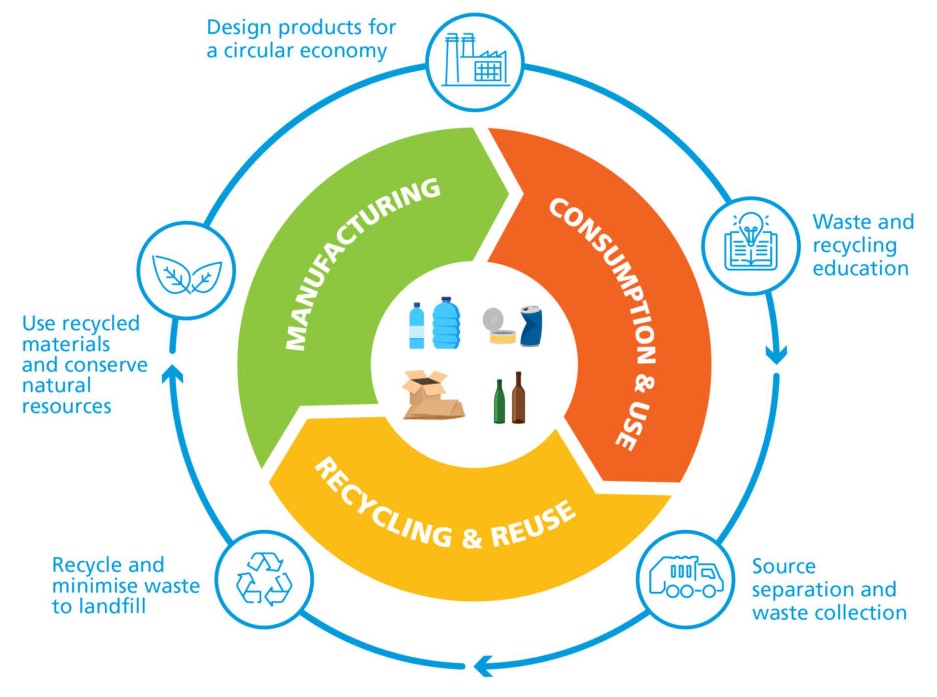The earth needs a makeover – and fast.
As the conversations around sustainability broaden around climate change, carbon emissions and the circular economy, we take a look at how recycling (and you) can play an important part.
How does recycling reduce our carbon footprint?
Our daily actions leave behind an invisible ‘footprint’. This carbon footprint can be big or small depending on the action, but one thing is for sure: we’re all contributing to carbon emissions.
Recycling limits the amount of virgin materials required to make our everyday products. This in turn lowers energy consumption during manufacturing. When we use less energy to make our products, we emit less carbon emissions.
Aluminium is a good example of how this works. Recycling aluminium for use in new products saves 95% of the energy required to manufacture aluminium products from raw aluminium in the form of bauxite ore.
Aluminium is an infinitely recyclable material, making it one of earth’s most sustainable materials. About 75% of all aluminium produced in history – amounting to roughly a billion tonnes – is still in use today.
When material such as aluminium is recycled and reused locally it also cuts down on the carbon emissions that result from transporting new products from factory to warehouse to store and finally to your home.
Tip: When shopping for your next electronic appliance or tool, check and compare Energy Rating labels before making your purchase to help you reduce your household carbon footprint.
How does recycling minimise the effects of climate change?
Climate change is defined as long term shifts in temperature and weather patterns. While these patterns occur naturally, climate change has accelerated rapidly since the 1800s due to human activity, in particular the release of GHG.
When solid waste heads to landfill it is broken down by bacteria into GHG such as methane and carbon dioxide.
Methane accounts for 25% of GHG worldwide. When averaged over 20 years, methane’s global warming potential is 86 times higher than carbon dioxide.
The same happens to the food we throw away. According to the World Wide Fund for Nature (WWF) we can reduce anywhere from 6% to 8% of all human caused GHG emissions by preventing food waste.
Tip: If you don’t have a kerbside organics bin, you can recycle your food scraps and garden waste by composting at home. Composting not only keeps organics from your general waste bin but also produces nutrient rich fertiliser for your plants and soil.
Recycling in the circular economy
For decades we have operated on a linear model: make – take – use – dispose. On the other hand, the circular economy works on the reduce – reuse – recycle principle. It effectively closes the loop on the products we consume by using a recycled product in the remanufacturing process.
Packaging and containers make up the largest volume of plastics waste in Australia. The good news is that most of these plastics can be recycled for use in the manufacture of new products.
When recycled materials such as recycled PET (rPET) are used to make new products it lowers our demand for raw or virgin materials, which our planet has in limited quantities.
What all of this means is that circularity puts us in a sustainable system where we’re continually reusing and recycling our resources, which in turn shrinks our carbon footprints.

Tip: Putting the wrong item in your commingled recycling bin can send a truck full of recyclable items to landfill. Clear the confusion around what you can and cannot recycle with our Recycling Hub.
What can you do to recycle better?
Our Recycling Behaviours Report shows that almost all Australians believe that recycling is important (92%). Many are motivated to recycle to help the environment (79%) and reduce waste sent to landfill (76%).
While the numbers show that we take a positive view of recycling, we’re still lacking in the knowledge department. The report shows that 34% of Australians still find recycling confusing and only 29% are correctly disposing of soft plastics through specialised recycling programs.
Here’s a simple list to help you up your recycling game:
- Know what your local council accepts in your recycling bin. When in doubt, leave it out!
- Turn your aluminium cans into cash for your charity of choice via container deposit schemes
- Keep your recyclables loose in the bin. You can flatten cardboard boxes but don’t squash your cans and bottles
- Leave your batteries out of your bins. Instead tape the terminals to prevent fires and store them in a glass container before taking them to your nearest battery recycling drop off point
- Avoid becoming a victim of fast fashion! You can take your preloved clothes to stores and clothing manufacturers run take-back programs.
You can get started on your recycling targets in time for this year’s National Recycling Week which takes place from 7 to 13 November 2022.
Contact us to learn more about how we’re making a sustainable future possible for communities and businesses across Australia.